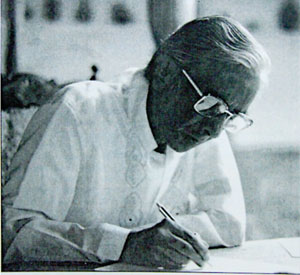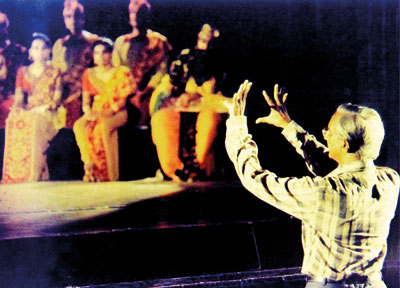Remembering Sarachchandra’s Maname, 60 years after
View(s):By Chandani Kirinde

Sarachchandra: A vision that has lived on
“I remember vividly the first night performance of Maname. As the curtain rose and the rich chant of the Pothegura (narrator) filled the auditorium, I sat spellbound at what seemed to me a theatrical miracle. Sarachchandra’s total transformation of ideas and theatrical aspects that he had taken from the traditional rituals and folk plays, into a sophisticated modern drama, the bare stage emblazoned with colourful costumes by the artist Siri Gunasinghe, the sheer poetry of the verse enhanced by his creative use of music and dance, left me and the audience stunned.” So recalled Professor Ranjini Obeysekere in an oration she delivered in 2014 to mark the birth centenary of Professor Ediriweera Sarachchandra whose epoch-making play Maname first staged at the Lionel Wendt Theatre in Colombo on November 3, 1956 turns 60 years this year.
“Manama Kathva” or the “Story of Maname” was a landmark theatre production, made on the basis of two types of village folk plays: the Kavi Nadagam, entirely in verse, and Kolam, performed with masks which Sarachchandra chose to experiment with. This was a departure from the populist theatre of the day that students at the University Campus, Peradeniya were accustomed to with adaptations of plays by French playwrights such as Molière and Guy de Maupassant as well as Russian writers Anton Chekhov and Nikolai Gogol notably popular.
However by 1956, the winds of change were not only blowing across the country’s political landscape with S.W.R.D.Bandaranaike sweeping to power in April ushering in the Government of the “common man’’. The Peradeniya Campus was also abuzz with news of the experimental drama that was taking shape with Ediriweera Sarachchandra, a senior lecturer in the Department of Sinhala in the vanguard.
Among the students was freshman Lionel Fernando who was excited about the new form of drama/theatre many were talking about. The story was an adaptation from the Culla Dhanuggaha Jathaka.
“It was around July 1956 when he (Sarachchandra) held a couple of auditions for those who were willing to help him in this new venture. I was among those who were keen to join it. The play was rehearsed taking most of the freshers for the various roles but for one of the main acts, that of the Veddah (the King of the Foresters) he looked beyond the campus and came upon a tall and brawny, determined man called Edmund Wijesinghe who went on to play the role to perfection,” recalled Fernando who now serves as the Director General of the Tower Hall Foundation Theatre (THFT).
What followed were several months of rehearsals in a room at the Senate Building at the campus. On hand assisting Sarachchandra was Ampe Charles De Silva Gunasinghe Gurunnanse, an evergreen name in the Nadagam style of drama in the Balapitiya area whom Sarachchandra had chanced upon as he travelled the country exploring various aspects of traditional forms of dance, drama and music.
“Even at the time he came to Peradeniya in 1956, Gunasinghe Gurunnanse may have been past 50 years. However he was a perfect dancer in the Nadagam style and perfect singer with precise pronunciation of Sinhala, Sanskrit and Pail languages,” says Fernando who was part of the original cast of Maname and played the role of Chief of the Foresters.
Gunasinghe Gurunnanse brought with him the drum known as the Maddalaya, used in operatic folk drama which proved the perfect ensemble along with other low country drums as Maname gradually took shape as a new stylized form of drama.
Maname (an opera in traditional style) was presented to the public by the University Sinhalese Drama Circle (Peradeniya) on November 3, 1956. It soon went on to become a popular drama attracting theatre-goers, first in and around Colombo and later in other cities countrywide as it caught the public’s attention. Since then Maname has been staged hundreds of times across the country with some of the biggest names in local theatre bringing to life the characters that have today become part of common lore.
Ranjini Obeysekere recalled watching Maname, years later, at the amphitheatre at Peradeniya campus fondly referred to by undergraduates and known famously as the Sarachchandra Wala.
“I remember attending again a performance of Maname. It was at the open air theatre – grass tiered seating under towering Tabebuia trees that shed their delicate pink blossoms on a packed audience of students, teachers, monks, government bureaucrats, workers and villagers from the surrounding areas. Then, in the scene where the lovers walk in the forest and the now familiar song “premeyen mana ranjita vey” was being sung, a student voice spontaneously joined in, and instantly the entire audience burst into the song. It was an unforgettable magical moment.”
It’s many magic moments like these that have endeared Maname to generations of Lankans and ensured that the legacy of Sarachchandra will live on through his works for decades to come.


